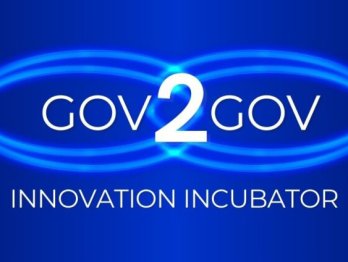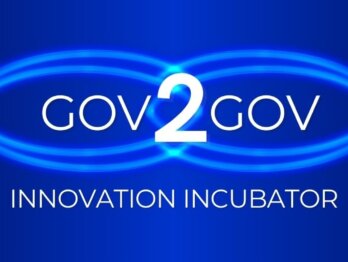The Greening Lab in Lyon: A mission-oriented approach in practice

An interview with Patrick Vincent, Public Innovation Director at the Open Innovation Lab of the Metropole of Lyon (ERASME).
The Metropole of Lyon, France’s second-largest public administration, has long fostered socio-environmental transitions through investments in soft mobility, urban climate resilience, sustainable food systems, and local solidarity. Yet, when tackling complex “wicked” problems, it often encounters what Patrick Vincent, Public Innovation Director at ERASME, described in our interview as “diminishing returns on investments and a ceiling for impact.” This recognition led them to pioneer a fundamentally different way of working through their Lab, aimed at addressing deeply rooted socio-technical habits and bridging diverse stakeholder cultures.
To enable transformative, whole system change, the Metropole’s Lab acts as a “think tank” and a “do tank”. It aims to bridge the gap between theory and action, and break silos within the administration to foster collective action.
A concrete example: The Greening Lab
In 2020, the Metropole of Lyon had a mission: to plant 300,000 trees in 10 years. Rather than treating it as a simple procurement and planting exercise, ERASME launched the innovation “Greening Lab” program (2020–2024). The Lab was designed based on the recognition that success depended on orchestrating a complex web of factors and actors: much of the available land for planting was privately owned, existing maintenance practices were not supporting biodiversity, and construction companies routinely damaged tree roots during other works. To truly transform Lyon into a greener city, an interconnected portfolio of solutions was necessary. Such a portfolio required, in turn, that people collaborated beyond their own “silo”, and the mobilisation of a wider ecosystem of actors – beyond the public administration.
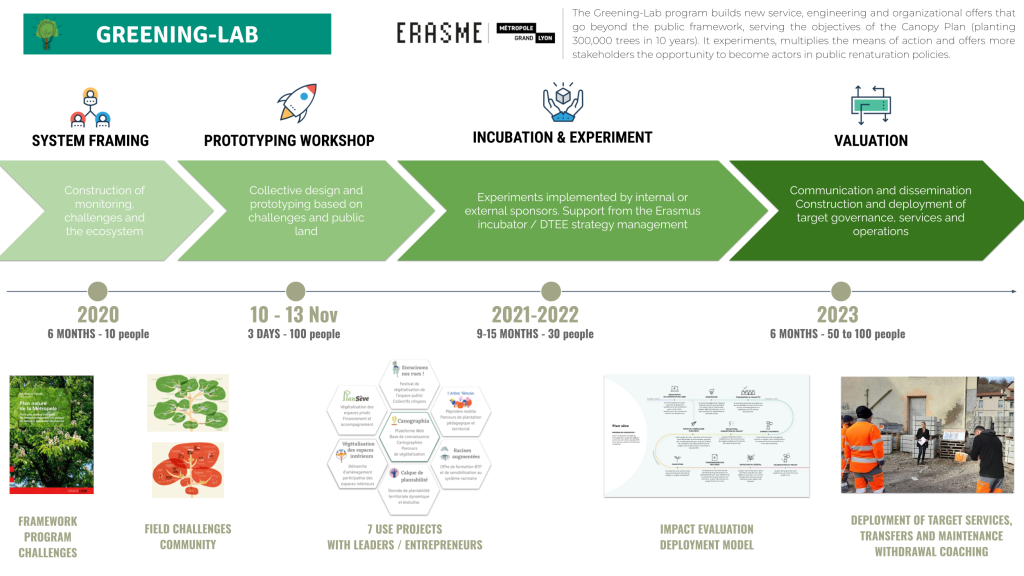
The Greening Lab proceeded in four phases. The first, system framing, involved six months working with a core team of 10 selected public servants to map the interconnections inherent in addressing the challenge, using systems thinking. Following this, a three-day intensive prototyping workshop engaged 100 stakeholders – including public servants and entrepreneurs – to prototype solutions. Third, a 12-month phase of incubation and experimentation allowed entrepreneurs to test solutions in practice. Finally, in the valuation phase, the solutions tested in the previous phase were valuated to identify the most effective interventions to scale up, and to generate learnings for future needs.
Seven interconnected initiatives were scaled up as a result of the Greening Lab, such as financing models for private landowners and educational programmes linking schools and elderly care homes to the tree-planting process.
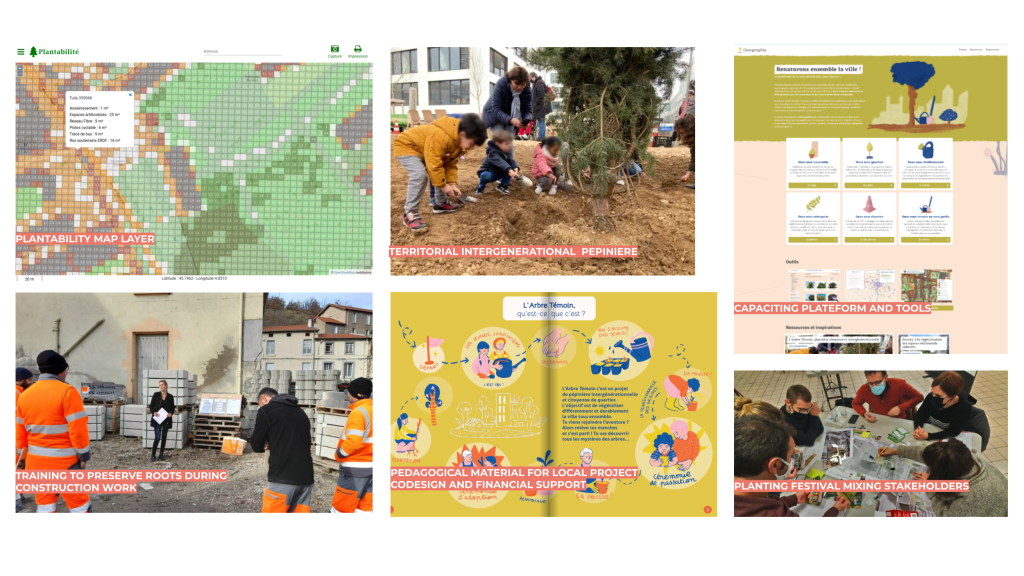
Some of the lessons learnt from the Greening Lab include:
- Beware of targets: While Lyon’s tree-planting initiative started with a numerical target (300,000 trees), the Lab recognised that achieving this goal required change across several systems and identifying cross-cutting challenges (e.g. shared capacities and knowledge, spatial/soil value and multi-capital accounting, cultural and professional change, territorial and social justice, legal and economic locks, future literacies and maintenance) -– not just the direct intervention to plant trees. Attention-grabbing targets are exciting, but mission-oriented approaches need to focus on the underlying systems they need to transform, as well as on which processes can trigger such transformation.
- Focus on underlying systems and look for indirect interventions with high potential for change. The Lab’s success came from managing a portfolio of interconnected initiatives rather than individual – and direct – interventions. In complex systems, direct interventions – while easier to evaluate compared to a numerical target – are not always the most effective way to get to results. Non-linearities in complex systems imply that indirect actions – like financing models, the engagement of “unusual suspects”, technical guides or educational tools – may be necessary and more effective to get to desired outcomes. Embracing agility, intrapreneurship, the right to fail/experiment, and moving beyond predictive models are also fundamental for actors in the system to think “outside the box” and transform the way of working of the administration from the inside.[1]
- Orchestrate stakeholder engagement: Not all stakeholders need to be involved from the onset. The image below shows the type of actors engaged in the Greening Lab as the project maturity advanced. For example, in the framing phase, only 10 public servants were involved. The subsequent phases gradually involved more people and extended the type of actors involved.
- Act and adapt: Rather than trying to plan for everything in advance, the Lab approach allowed for stakeholders to discover and adapt as emerging shared knowledge became available from previous phases. Flexible governance structures were needed to allow for – and capitalise on – the learnings of such a process.
Environmental challenges require new ways of working that match the complexity of the problems they aim to solve. The Metropole of Lyon Innovation Lab shows how combining systems thinking with collaboration across a wide ecosystem of actors can help territories move from linear problem-solving to creating living systems of change. More broadly, it demonstrates how mission-oriented approaches can be effectively implemented at the local level through institutional innovation and new ways of working.
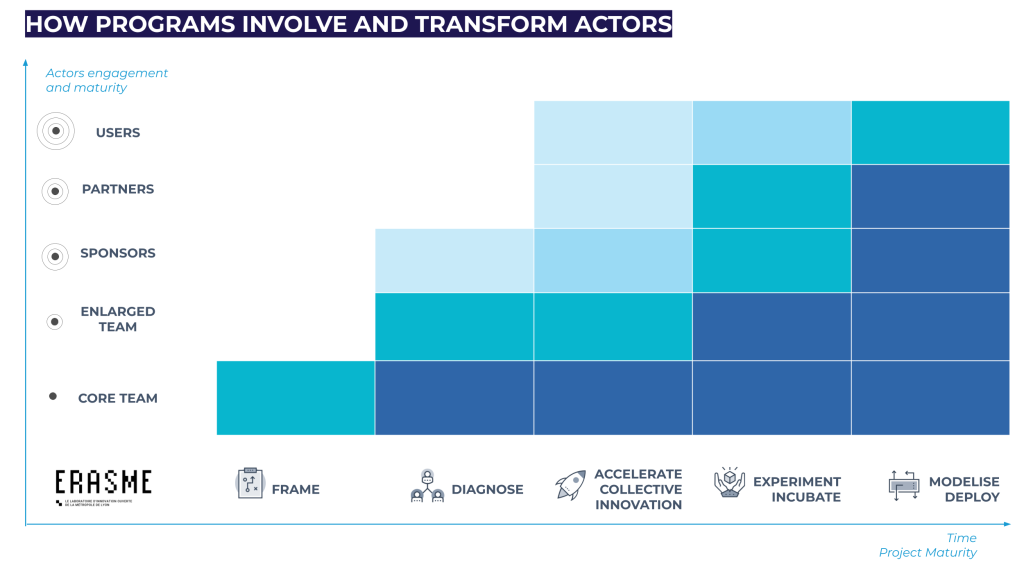
[1] The OECD has developed a methodology to help identify interventions with high potential for change, referred to as transformative policies.
This blog is funded by the European Union. Its contents are the sole responsibility of the authors and do not necessarily reflect the views of the European Union.


